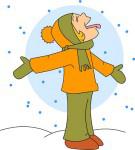After Christmas comes holiday vacation time, a time for outdoor fun activities for children.
 The American Academy of Pediatrics (AAP) recommends the following tips for keeping children safe while outdoors in the winter.
The American Academy of Pediatrics (AAP) recommends the following tips for keeping children safe while outdoors in the winter.
What to Wear
Dress infants and children warmly for outdoor activities. Several thin layers will keep them dry and warm. Don’t forget warm boots, gloves or mittens, and a hat. The rule of thumb for older babies and young children is to dress them in one more layer of clothing than an adult would wear in the same conditions.
When participating in activities such as ice skating, sledding, snow skiing and snowboarding, consider having your child wear a helmet.
Sun Protection
The sun’s rays can still cause sunburn in the winter, especially when they reflect off snow. Make sure to cover your child’s exposed skin with sunscreen.
Hypothermia
Hypothermia develops when a child’s temperature falls below normal due to exposure to colder temperatures. It often happens when a youngster is playing outdoors in extremely cold weather without wearing proper clothing or when clothes get wet. It can occur more quickly in children than in adults.
As hypothermia sets in, the child may shiver and become lethargic and clumsy. Speech may become slurred and body temperature will decline in more severe cases. If you suspect your child is hypothermic, call 911 at once. Until help arrives, take the child indoors, remove any wet clothing, and wrap him in blankets or warm clothes.
Frostbite
Frostbite happens when the skin and outer tissues become frozen. This condition tends to happen on extremities like the fingers, toes, ears and nose. They may become pale, gray and blistered. At the same time, the child may complain that his/her skin burns or has become numb.
If frostbite occurs, bring the child indoors and place the frostbitten parts of her body in warm (not hot) water. Warm washcloths may be applied to frostbitten nose, ears and lips. Do not rub the frozen areas. After a few minutes, dry and cover the child with clothing or blankets. Give him/her something warm to drink.
If the numbness continues for more than a few minutes, call your doctor.
Frostbite facts from Rhode Island Hospital’s Burn Center.
Supervision
Children should be supervised while participating in all winter outdoor activities. Older children’s need for adult supervision depends on their maturity and skill. If older children are not with an adult, they should always at least be accompanied by a friend. Never let your child sled, skate, ski or snowboard alone.
Ice Skating
Allow children to skate only on approved surfaces. Check for signs posted by local police or recreation departments, or call your local police department to find out which areas have been approved. Advise your child to:
- Skate in the same direction as the crowd.
- Avoid darting across the ice.
- Never skate alone.
- Not chew gum or eat candy while skating.
Sledding
- Keep sledders away from motor vehicles.
- Keep young children separated from older children.
- Sledding feet first or sitting up, instead of lying down head-first, may prevent head injuries.
- Use steerable sleds, not snow disks or inner tubes.
- Sleds should be structurally sound and free of sharp edges and splinters, and the steering mechanism should be well lubricated.
- Sled slopes should be free of obstructions like trees or fences, be covered in snow not ice, not be too steep (slope of less than 30º), and end with a flat runoff.
- Avoid sledding in crowded areas.
Snow Skiing and Snowboarding
- Children should be taught to ski or snowboard by a qualified instructor in a program designed for children.
- Equipment should fit the child. Skiers should wear safety bindings that are adjusted at least every year. Snowboarders should wear gloves with built-in wrist guards. Eye protection or goggles should also be used.
- Slopes should fit the ability and experience of the skier or snowboarder.
- Avoid crowded slopes. Avoid skiing in areas with trees and other obstacles.
Snowmobiling
-
The AAP recommends that children under age 16 not operate snowmobiles and that children under age 6 never ride on snowmobiles.
- Do not use a snowmobile to pull a sled or skiers.
- Wear goggles and a safety helmet approved for use on motorized vehicles like motorcycles.
- Travel at safe speeds.
- Never use alcohol or other drugs before or during snowmobiling.
- Stay on marked trails, away from roads, water, railroads and pedestrians.
 The American Academy of Pediatrics (AAP) recommends the following tips for keeping children safe while outdoors in the winter.
The American Academy of Pediatrics (AAP) recommends the following tips for keeping children safe while outdoors in the winter.
